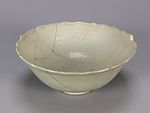Bowl
About this object
History of use
Chinese ceramics were important trade items in southeast Asia during the 11th-16th centuries and became fully integrated with ideology and ritual in Philippine societies, playing an important role in all aspects of cultural life (Langrick, p.61). Their functions were varied and included utilitarian, ceremonial and religious roles as heirlooms, and in mortuary ceremonies as burial goods and items of prestige. Chinese ceramics constitute the vast majority of burial goods excavated in the Philippines. Buried with the deceased, they acted as indicators of wealth, protected the departing spirit from evil and serving as provisions for the afterlife. Turned-over plates and bowls were used to cover certain parts of the body, establishing a protective area. In addition, many excavated ceramics were miniaturized replicas of larger, functional vessels--symbolic substitutes for provisions for the afterlife. In addition, small jarlets and bottles and other containers were used for ritual substances (oils, herbs, aromatic resins) and for food offerings necessary for the departing spirit. Most of the trade ceramics excavated in the Philippines show little or no evidence of usage before burial. Shu-fu ware in the Philippines context is described, by Addis, as being manufactured in Jingdezhen in the county of Fuliang in China, and as having at least two of the following characteristics: slip decoration in the interior impressed by a mould; a neat, splayed, square-cut foot and an opaque, milky, pale bluish-white glaze (p.4-5). Addis dates Shu-fu ware to the Yuan dynasty (1260-1368) and perhaps later. From the condition of trade ceramics shown in published sources and the Tecson collection, it appears that most of the wares were kiln seconds, or rejects. They were nevertheless regarded with high esteem and actively traded.
Narrative
This bowl is part of a collection of Chinese ceramics found in burial context in the Philippines and was excavated at a burial site in Lumban, Laguna Province, Philippines. Repairs were done by specialists employed by archaeologists and the Philippines National Museum. They were artists by training.
Cultural context
exchange; status; ceremonial; mortuary
Iconographic meaning
In many indigenous groups of the Philippines, supernatural power was attributed to Chinese ceramics because of the ringing sound emitted when lightly tapped and their vitreous, shiny glazed surfaces which impart an impermeable quality. The ringing sound was seen as a magical voice able to attract the attention of powerful ancestor spirits. Their impermeable and seemingly imperishable surfaces were believed to have great protective power against all kinds of influences, from evil spirits to poisons (Langrick, p. 55-56).
Specific techniques
The thickened welt of glaze just below the rim is, according to Medley, a feature due to the method of glazing. When applied, the glaze was evidently allowed to run towards the rim after dipping (p. 175-176). Addis especially points out the foot of this group of dishes and distinguishes it from a classical Sh-fu foot which slightly splays outwards, is completely covered with glaze on the outside, strong, solid and neatly cut on all surfaces (p. 4-5). Rather, this type of Sh-fu dish has feet which are about 1/4 inch high, not at all splayed and having bases which are either not cut at all, being left crudely flat, or is very shallow and roughly cut leaving a coarse foot rim about 1/4 inch wide (p. 9).
Physical description
Broken, reassembled and repaired round bowl with a foliated rim of eight lobes and unglazed flat foot. The cavetto is decorated with a moulded design of eight panels each containing a motif although this is only faintly discernible. Glaze appears to be thickest just below the rim both on the inside and outside. Centre has some grit incorporated. Exterior surface is plain. Inked number on the foot.
Date Made
Song Dynasty (960-1279)
Date Acquired
16 Nov 1987
How Acquired
Donated
Credit Line
Measurements
7.4 x 17.6 cm
Object Number
Ia286
